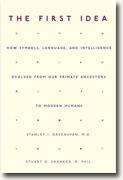Stanley I. Greenspan & Stuart G. Shanker
book reviews:
· general fiction
· chick lit/romance
· sci-fi/fantasy
· graphic novels
· nonfiction
· audio books
· author interviews
· children's books @
curledupkids.com
· DVD reviews @
curledupdvd.com
newsletter
win books
buy online
links
home
for authors
& publishers
for reviewers

 |
The First Idea: How Symbols, Language, and Intelligence Evolved from our Primate Ancestors to Modern Humans Stanley I. Greenspan & Stuart G. Shanker Da Capo Press Paperback 512 pages January 2006 |
|
“What was the first idea?” Good question, and that’s exactly how co-authors Stanley Greenspan, Clinical Professor of Psychiatry and Pediatrics at George Washington University, and Stuart Shanker, Professor of Philosophy and Psychology at York University introduce a hypothesis that challenges previously-held doctrines.
It’s a theory that is at odds with leaders in the field -- Stephen Pinker (“The Blank Slate”) and Noam Chomsky (the MIT linguist responsible for popularizing the belief that aspects of our language are “hard-wired” in our psyche). Both Pinker and Chomsky assert that it was genetic change that steered evolutionary change and allowed humans to develop symbolic thinking and speaking. In order to set the stage for their revolutionary theory, Greenspan and Shank begin in Part I with an introduction to the origin and development of symbols, past study and theories and then move into questioning these findings. In Part II, the authors continue with the process leading to their “new model of evolution,” looking at emotional regulation, problem-solving, symbols, words and ideas, and the birth of logic. The development of language and intelligence, current beliefs and new theory is discussed in Part III, with “implications for a new view of language, cognition, autism and the development and functioning of the brain.” Here the authors review the role of emotions in language development, emotions and the development of intelligence and delve into “pathways to and from autism.” Part IV looks at the development of social groups and the future evolution of humanity as we move towards global interdependency based on the new hypothesis. While this book will be greatly appreciated by those working or interested in psychology and child development, it’s not a light read. It’s a serious book with a mission -- to introduce a new view and challenge the way we currently look at human evolution, intelligence and thinking. I’d highly recommend this book for professionals, but it’s not for the average reader with only a passing interest in scientific theory. © 2004 by Megan Kopp for curledup.com. |
| Also by Stanley I. Greenspan, MD: |
|
|
|
 Click here to learn more about this month's sponsor! |
|
| fiction · sf/f · comic books · nonfiction · audio newsletter · free book contest · buy books online review index · links · · authors & publishers reviewers |
|
| site by ELBO Computing Resources, Inc. | |
 The authors set out to show that “the capacity to create symbols and to think stems from what was often though of by philosophers as the ‘enemy’ of reason and logic: our passions and emotions.” They also infer that these “uniquely human abilities” are learned; not passed on genetically or through natural selection.
The authors set out to show that “the capacity to create symbols and to think stems from what was often though of by philosophers as the ‘enemy’ of reason and logic: our passions and emotions.” They also infer that these “uniquely human abilities” are learned; not passed on genetically or through natural selection.